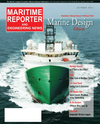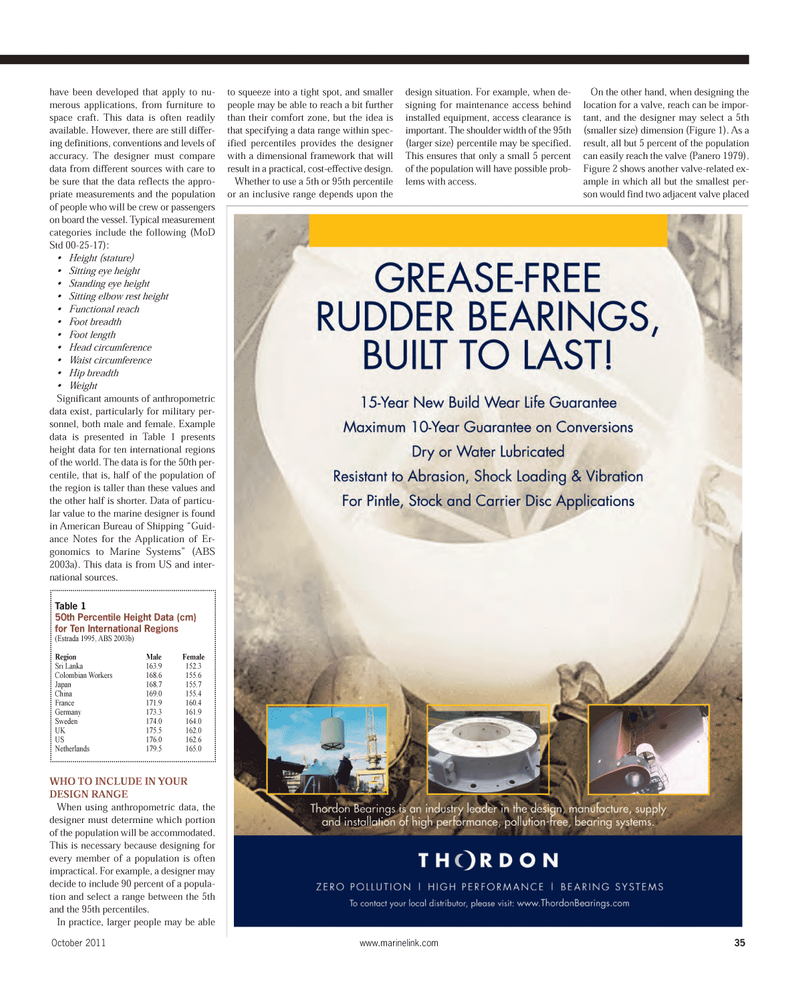
Page 35: of Maritime Reporter Magazine (October 2011)
Marine Design Annual
Read this page in Pdf, Flash or Html5 edition of October 2011 Maritime Reporter Magazine
October 2011www.marinelink.com 35have been developed that apply to nu- merous applications, from furniture tospace craft. This data is often readily available. However, there are still differ- ing definitions, conventions and levels of accuracy. The designer must compare data from different sources with care to be sure that the data reflects the appro-priate measurements and the populationof people who will be crew or passengers on board the vessel. Typical measurement categories include the following (MoD Std 00-25-17):Height (stature) Sitting eye height Standing eye height Sitting elbow rest height Functional reach Foot breadth Foot length Head circumference Waist circumference Hip breadth Weight Significant amounts of anthropometric data exist, particularly for military per- sonnel, both male and female. Exampledata is presented in Table 1 presents height data for ten international regions of the world. The data is for the 50th per- centile, that is, half of the population ofthe region is taller than these values and the other half is shorter. Data of particu- lar value to the marine designer is found in American Bureau of Shipping ?Guid- ance Notes for the Application of Er- gonomics to Marine Systems? (ABS2003a). This data is from US and inter- national sources. WHO TO INCLUDE IN YOUR DESIGN RANGEWhen using anthropometric data, thedesigner must determine which portionof the population will be accommodated.This is necessary because designing forevery member of a population is often impractical. For example, a designer may decide to include 90 percent of a popula-tion and select a range between the 5thand the 95th percentiles. In practice, larger people may be able to squeeze into a tight spot, and smallerpeople may be able to reach a bit furtherthan their comfort zone, but the idea is that specifying a data range within spec-ified percentiles provides the designer with a dimensional framework that will result in a practical, cost-effective design. Whether to use a 5th or 95th percentileor an inclusive range depends upon the design situation. For example, when de- signing for maintenance access behindinstalled equipment, access clearance isimportant. The shoulder width of the 95th (larger size) percentile may be specified. This ensures that only a small 5 percentof the population will have possible prob- lems with access. On the other hand, when designing thelocation for a valve, reach can be impor- tant, and the designer may select a 5th(smaller size) dimension (Figure 1). As a result, all but 5 percent of the population can easily reach the valve (Panero 1979). Figure 2 shows another valve-related ex- ample in which all but the smallest per- son would find two adjacent valve placed Table 1 50th Percentile Height Data (cm) for Ten International Regions(Estrada 1995, ABS 2003b) RegionMaleFemale Sri Lanka163.9152.3 Colombian Workers168.6155.6 Japan168.7155.7 China169.0155.4 France171.9160.4 Germany173.3161.9 Sweden174.0164.0 UK175.5162.0 US176.0162.6 Netherlands179.5165.0 MR Oct.11 # 5 (34-41):MR Template 10/5/2011 12:45 PM Page 35

 34
34

 36
36
